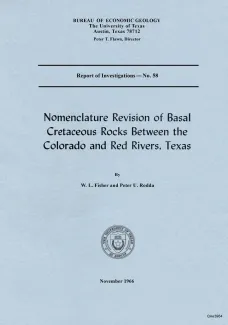
Publication Details
Geolocation:
Get the Publication
$14.00
Abstract/Description:
Based on need for convenient, small-scale cartographic units, the basal Cretaceous rocks in Texas from Red River to Burnet County and on the Callahan Divide are herein divided into three distinctive lithologic sequences. These are recognized by changes in facies and by the presence or absence of overlying definitive units and include: (1) North-central Texas sequence overlain by the Glen Rose Formation and characterized by siliceous conglomerates and lack of carbonate units (Twin Mountains Formation) (new name); (2) North Texas and West-central Texas sequences extending beyond pinch-out of the Glen Rose Formation with basal and stratigraphically higher clastics included in a single unit (Antlers Formation); (3) Central Texas sequence overlain by Glen Rose Formation but characterized by carbonate units and coarse, locally derived, limestone and dolomite conglomerates (Travis Peak Formation). The outcrop sequence of North-central Texas grades eastward in the subsurface to a basinal sequence overlain by the Glen Rose Formation and divided into (in ascending order) the Hosston, Sligo, Pearsall, and Hensel Formations. The name Trinity is confusing in its various uses and should be reserved for higher rank units, i.e., Group or Division, where such units are judged necessary and are clearly defined in areal scope as well as vertical sequence.